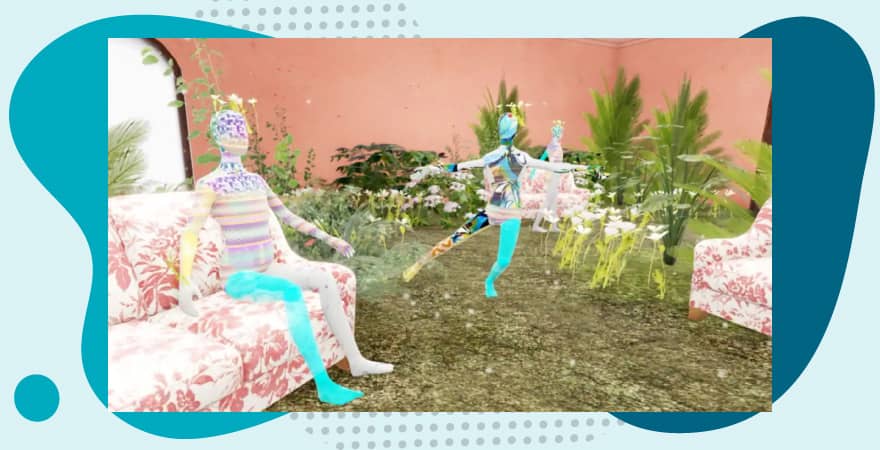Building a brand in the metaverse
| May 17, 2022

What do Snoop Dogg, Nike, Sotheby’s, and PwC all have in common? They’ve all invested in real estate in the metaverse.
Looking beyond the world we see in two dimensions on screens—phones, laptops, desktops, or iPads—they have decided to purchase a plot of pixels in a three-dimensional virtual world we can experience through a headset.
These are just a few of the entrepreneurs and brands experimenting with new forms of audience engagement. So, what can we learn about brand building in the metaverse from these pioneers?
There is a multiverse of virtual environments
While the word “metaverse” sounds like one place where everyone’s digital avatar is hanging out, the reality is a multiverse: A series of different 3D worlds on different platforms. These platforms are typically world-building games.
You’ll find Snoop in The Sandbox, where you can “attend Snoop’s private metaverse parties, get access to exclusive NFTs, and enjoy priceless experiences.” More about non-fungible tokens (NFTs) in a moment—in the metaverse, nothing is going to be free.

Let’s leave The Sandbox and join Roblox, where you can try out the virtual skatepark built by a company synonymous with skateboarding, the California footwear brand Vans, or join the nine million-plus virtual athletes who enjoy the sports challenges in Nike Land.
Head over to Decentraland and you can find Sotheby’s auction house and a virtual version of Samsung’s New York store. The Samsung store was launched to coincide with CES 2022. Visitors can start a quest “exploring, playing, and collecting” digital assets.
If you join the 350 million gamers who play Fortnite, you will encounter brands galore—from Marvel to Wendy’s. Then, of course, there’s Facebook—sorry—Meta’s own Horizon platform and Horizon Workrooms for workplace collaboration.
In short, the metaverse is not just a revival of the early iteration of a virtual world, Second Life, which saw brands populate “islands” in the same environment. Today, brands are deciding where they want to be in the metaverse—or, like AMC’s Walking Dead TV series, choosing to exist in different forms in a number of these virtual worlds at the same time.
What’s striking is that the early winners in the metaverse are the brands that speak to an authentic identity—with a twist that’s relevant in these new environments.
E-commerce is turning into I-commerce
Some of the most successful brands and entrepreneurs have moved beyond e-commerce into i-commerce, or immersive commerce—transactions based on users’ deeper interactions in this new digital environment.
Take the example of The Gucci Garden exhibition in Roblox for two weeks in May 2021. The Gucci Gardens took the form of different rooms. Upon entering them, visitors’ avatars became neutral mannequins—effectively blank canvases—absorbing different elements of the exhibition as they passed through.
“With every person experiencing the rooms in a different order and retaining different fragments of the spaces, they will emerge at the end of their journey as one-of-a-kind creations, reflecting the idea of individuals as one among many, yet wholly unique,” Roblox said when announcing the Gucci Garden.

Visitors could then buy virtual Gucci products to dress or accessorize their avatars. Such was the demand for Gucci products that a bee-embroidered digital bag that was initially sold for 475 Robux (about $6) was resold for 350,000 Robux (about $4,115). That’s about $800 more than the bag costs in the real world. Was it popular? Ask the 19.9 million visitors who made a virtual trip.
Sotheby’s virtual re-creation of its London auction rooms (with the exception of the yellow ape that greets you at the door) gives a stamp of authority to the trading of NFTs—the one-of-a-kind digital assets that are being traded in the metaverse.
These unique assets range from video or audio clips to memes to Jack Dorsey’s first tweet, which sold for just under $3 million.
According to Max Moore, head of contemporary art auctions at Sotheby’s Asia, “We realized we could play a very important role in this burgeoning market, given our current role in the contemporary art market and the physical collectibles world, where we bridge the gap between the two worlds.”
What’s clear is whether it is Vans’ skatepark, the Gucci Garden, or a Sotheby’s NFT auction, pioneer brands that are chalking up early success in the metaverse are doing so by creating an immersive virtual experience that says something about who or what they are—not an alternative brand to their physical reality.
They are having fun with their brand, for sure. There is a playfulness that fits the platform. But the core values and identity that we would find in the brand in the physical world is retained—just with added yellow apes.
Test and learn, but stay faithful to your brand
Marketing has always looked to test innovative platforms, going back to the first digital ad run by AT&T in 1994 (“Have you ever clicked your mouse right here? You will.”).
That’s because meeting people where they are is a core tactic that remains true, even if where people are today is a virtual world rather than a physical one.
Whether the metaverse is the future of human interaction in digital environments remains to be seen. For now, brands must explore it. But, in doing so, there’s another truth to hold on to: Brand integrity and managing consistency always matter, regardless of the platform.
Originally published on FastCompany.
